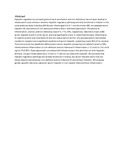Iron status and systemic inflammation, but not gut inflammation, strongly predict gender-specific concentrations of serum hepcidin in infants in rural Kenya.

View/
Date
2013-02-27Author
Mwangi, A
Jaeggi, T
Moretti, D
Kvalsvig, J
Holding, PA
Jaeggi, T
Moretti, D
Kvalsvig, J
Holding, PA
Tjalsma, H
Kortman, GA
Joosten, I
Zimmermann, MB
Type
ArticleLanguage
enMetadata
Show full item recordAbstract
Hepcidin regulation by competing stimuli such as infection and iron deficiency has not been studied in infants and it's yet unknown whether hepcidin regulatory pathways are fully functional in infants. In this cross-sectional study including 339 Kenyan infants aged 6.0±1.1 months (mean±SD), we assessed serum hepcidin-25, biomarkers of iron status and inflammation, and fecal calprotectin. Prevalence of inflammation, anemia, and iron deficiency was 31%, 71%, 26%, respectively. Geometric mean (±SD) serum hepcidin was 6.0 (±3.4) ng/mL, and was significantly lower in males than females. Inflammation (C-reactive protein and interleukin-6) and iron status (serum ferritin, zinc protoporphyrin and soluble transferrin receptor) were significant predictors of serum hepcidin, explaining nearly 60% of its variance. There were small, but significant differences in serum hepcidin comparing iron deficient anemic (IDA) infants without inflammation to iron-deficient anemic infants with inflammation (1.2 (±4.9) vs. 3.4 (±4.9) ng/mL; P<0.001). Fecal calprotectin correlated with blood/mucus in the stool but not with hepcidin. Similarly, the gut-linked cytokines IL-12 and IL-17 did not correlate with hepcidin. We conclude that hepcidin regulatory pathways are already functional in infancy, but serum hepcidin alone may not clearly discriminate between iron-deficient anemic infants with and without infection. We propose gender-specific reference values for serum hepcidin in iron-replete infants without inflammation.
Citation
PLoS One. 2013;8(2):e57513. doi: 10.1371/journal.pone.0057513. Epub 2013 Feb 27.Publisher
Universty of Nairobi
